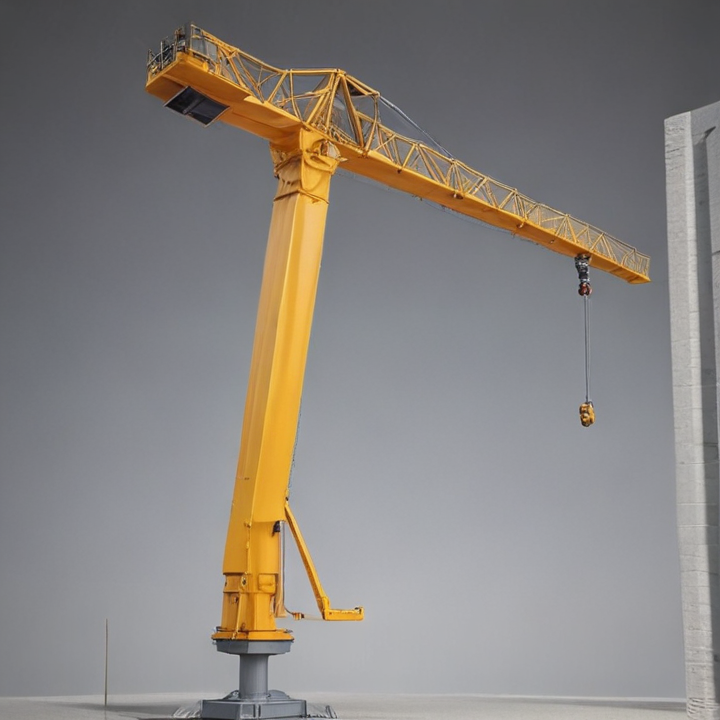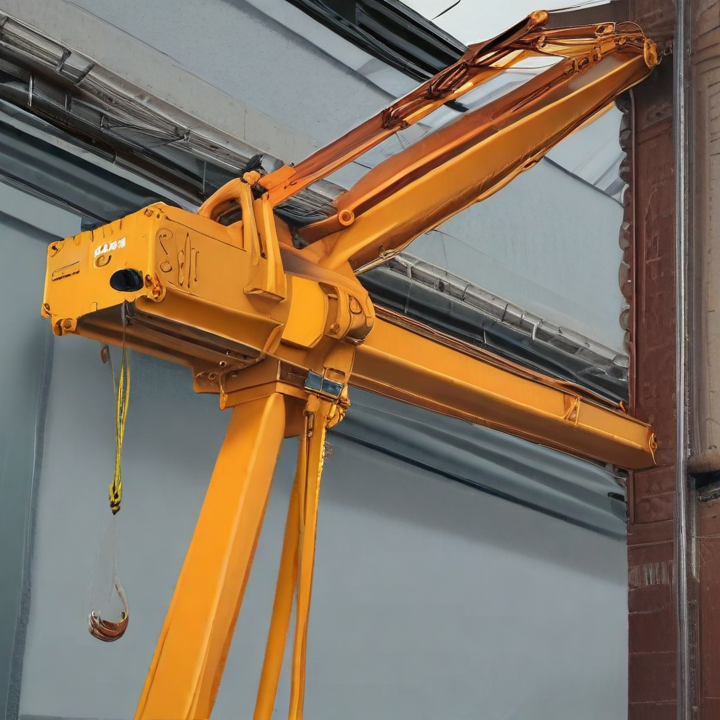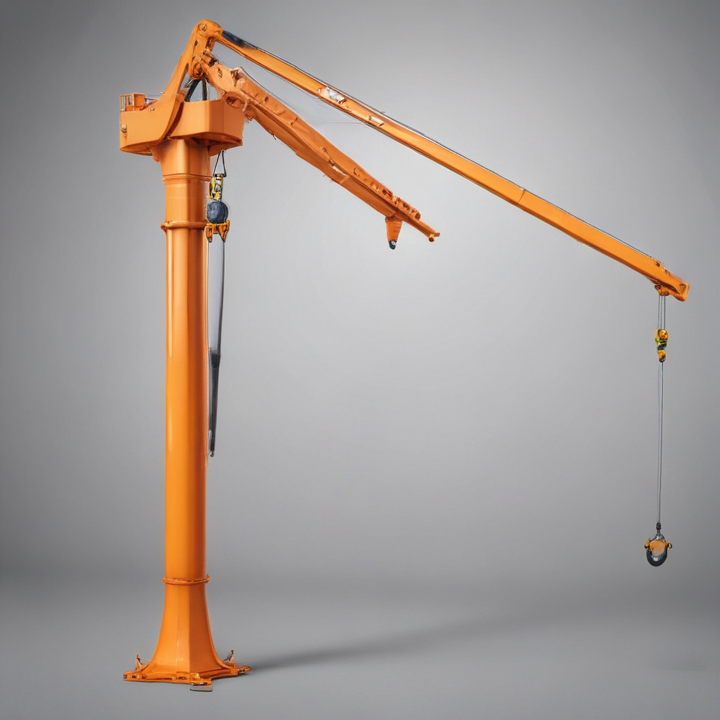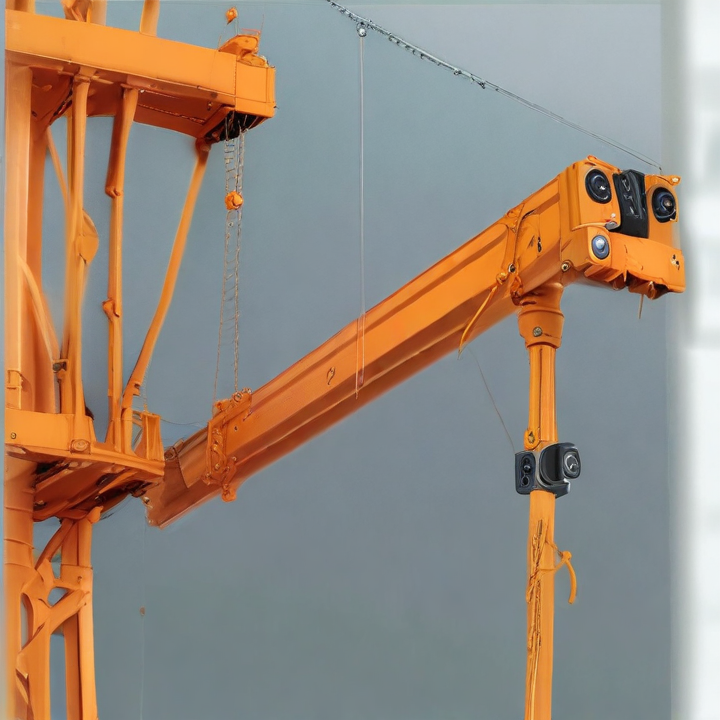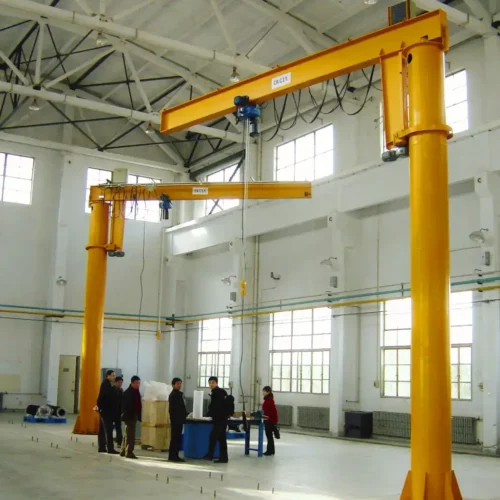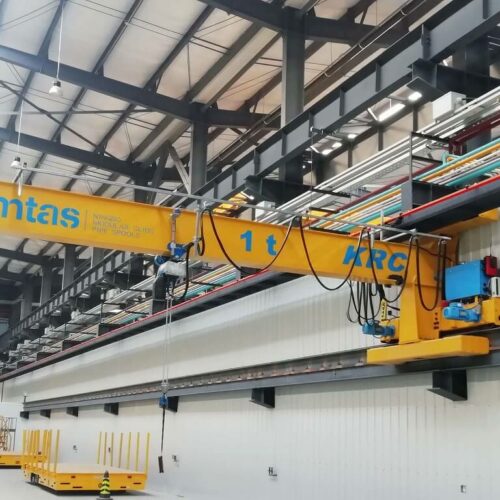column mounted jib crane Safety Certifications
Column-mounted jib cranes are essential tools in various industries for lifting and transporting materials. Ensuring their safe operation requires adherence to a variety of safety certifications and standards. Here’s an overview of some of the key certifications and guidelines:
1. OSHA (Occupational Safety and Health Administration): In the United States, OSHA provides regulations for the safe operation of lifting equipment, including jib cranes. Compliance with OSHA standards ensures the crane is designed, maintained, and operated to minimize hazards.
2. ANSI (American National Standards Institute): ANSI standards, particularly ANSI B30.11, provide comprehensive safety guidelines for the design, construction, installation, and use of jib and other types of cranes. These standards help in minimizing risks associated with crane operation.
3. ASME (American Society of Mechanical Engineers): ASME B30.11 offers detailed criteria for the safe installation, maintenance, inspection, and testing of jib cranes. Following ASME guidelines ensures the structural integrity and safe functioning of cranes.
4. CE Marking (Conformité Européenne): For European markets, the CE mark is mandatory, indicating that the jib crane complies with EU safety, health, and environmental protection requirements. This involves adhering to the Machinery Directive 2006/42/EC.
5. ISO (International Organization for Standardization): ISO 9927 and ISO 4309 provide international standards for the inspection and maintenance of cranes. These standards ensure jib cranes meet global safety benchmarks.
6. CSA (Canadian Standards Association): In Canada, CSA B167 sets the safety standards for jib cranes, emphasizing the importance of regular inspections and maintenance.
7. Lifting Operations and Lifting Equipment Regulations (LOLER): In the UK, LOLER regulations govern the safe operation of lifting equipment, mandating regular inspections and thorough maintenance protocols for jib cranes.
In summary, ensuring a column-mounted jib crane meets OSHA, ANSI, ASME, CE, ISO, CSA, and LOLER standards is crucial for safe operation. Compliance with these certifications not only safeguards workers but also prolongs the lifespan of the equipment.
List Reference Technical Parameters of “column mounted jib crane”
A column-mounted jib crane is a versatile lifting device, commonly used in manufacturing and industrial settings. Here are some key technical parameters to consider:
1. Load Capacity: Defines the maximum weight the jib crane can lift, typically ranging from 0.5 to 10 tons.
2. Span (Boom Length): The horizontal distance from the crane’s mast to the end of the boom, available from 2m to 10m or longer, depending on the model.
3. Height Under Boom: This refers to the vertical distance from the ground to the underside of the jib, usually customizable to specific facility requirements. Standard heights range from 2m to 6m.
4. Rotation: The degree to which the boom can rotate around the mast; standard models typically offer 180° or 360° rotation.
5. Mast Dimensions: The diameter and height of the column, which needs to be strong enough to support the boom and the maximum load, often specified in the manufacturer’s guidelines.
6. Base Plate Dimensions: The dimensions and thickness of the base plate that anchors the column to the ground, ensuring stability and safety.
7. Hoist Units: Compatibility with different types of hoists (manual, electric, or pneumatic). The hoisting speed and capacity must match the crane’s specifications.
8. Installation Requirements: Guidelines about the foundation and anchoring, including details like concrete specifications and bolt sizes for secure installation.
9. Electric Power Supply: For electric hoists, specify voltage and phase requirements (e.g., 220V single-phase or 380V three-phase).
10. Control System: Options available, such as push-button pendant controls, remote controls, or automated systems.
11. Environmental Conditions: Operational range for temperature, humidity, and potential exposure to corrosive substances, which may necessitate special coatings or materials.
12. Compliance Standards: Adherence to industry standards and safety regulations, such as OSHA, ANSI, and ISO certifications.
These parameters ensure the crane operates effectively, safely, and meets the specific needs of the application environment.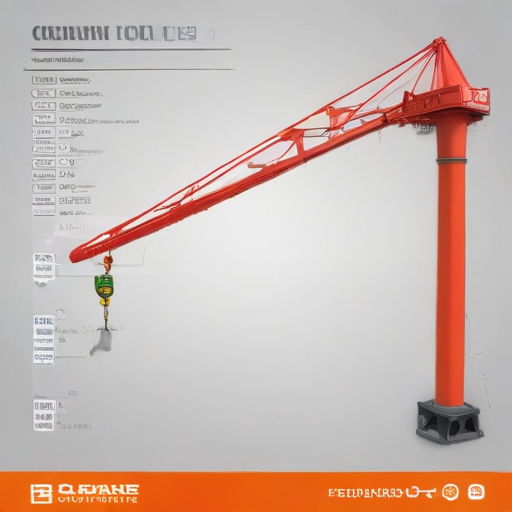
List Product features of “column mounted jib crane”
A column-mounted jib crane is a versatile lifting device used in various industrial settings to aid in the movement of heavy materials. Here are the key features of a column-mounted jib crane:
1. 360-Degree Rotation: The jib arm typically allows for full 360-degree rotation, providing maximum coverage and flexibility within the work area.
2. High Load Capacity: These cranes can handle heavy loads, with many models capable of lifting several tons. The specific load capacity will vary depending on the design.
3. Adjustable Arm Length: The length of the jib arm can often be adjusted to suit different operational needs, allowing for customization based on the specific work environment.
4. Robust Construction: Made from high-quality steel or other durable materials, these cranes are designed to withstand rigorous use and offer long-lasting performance.
5. Easy Installation: Column-mounted jib cranes are relatively straightforward to install, requiring a solid foundation to secure the column. They can be mounted indoors or outdoors depending on the requirements.
6. Safety Features: Most models include safety features like overload protection, emergency stop mechanisms, and secure mounting options to ensure safe operation.
7. Low Maintenance: Designed for durability, these cranes require minimal maintenance, reducing downtime and operational costs.
8. Versatility: Suitable for various applications, including assembly lines, warehouses, and maintenance facilities, providing a versatile solution for material handling.
9. Ergonomic Operation: These cranes are designed to reduce manual labor and minimize workplace injuries, enhancing overall productivity and worker safety.
10. Customization Options: Many manufacturers offer customization options such as different heights, arm lengths, and mounting configurations to meet specific industrial needs.
11. Integration with Hoists: They are compatible with different types of hoists (electric, manual, chain, or wire rope), enhancing their usability for various lifting tasks.
12. Smooth Operation: Precision-engineered components ensure smooth, efficient operation, minimizing the effort required to move heavy loads.
In summary, the column-mounted jib crane is a highly adaptable and efficient lifting solution with robust construction, high load capacity, and an array of safety and customization features, making it ideal for various industrial applications.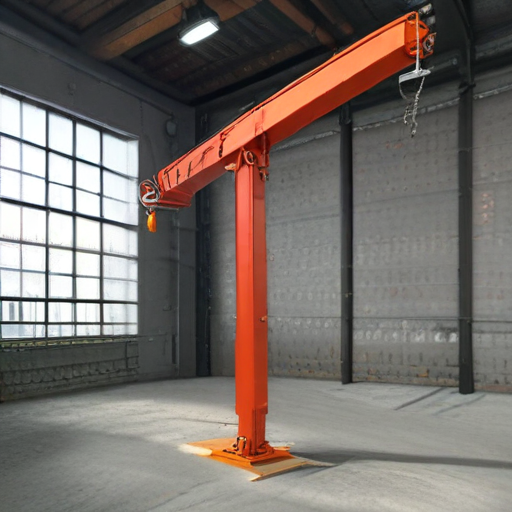
List Various Types of “column mounted jib crane”
Column-mounted jib cranes are versatile lifting devices that are often used in manufacturing, maintenance, and assembly applications. Here are various types of column-mounted jib cranes that you might come across:
1. Manual Rotation Jib Cranes:
– These cranes feature a jib arm that rotates manually. They are cost-effective and suitable for applications where motorized rotation is not necessary.
2. Motorized Rotation Jib Cranes:
– Equipped with a motor for the rotation of the jib arm, these cranes are useful in applications requiring frequent and effortless rotation.
3. Articulating Jib Cranes:
– These cranes have an additional knuckle or joint, allowing for greater flexibility and a wider range of motion, making them ideal for areas with obstacles or complex layouts.
4. Wall-Traveling Jib Cranes:
– These cranes are mounted on a vertical column and travel along a track fixed to a wall. They provide extended coverage over a larger area compared to stationary models.
5. Mast-Type Jib Cranes:
– Featuring a freestanding mast, these cranes do not require a ceiling or overhead support and are ideal for facilities where overhead space is limited.
6. Floor-Mounted Jib Cranes:
– Similar to mast-type cranes but bolted directly to the floor, providing a stable and robust lifting solution.
7. Portable Jib Cranes:
– These cranes can be moved to different locations as needed, providing flexible lifting solutions for various tasks.
8. I-Beam Jib Cranes:
– Utilizes an I-beam for the jib arm, allowing for heavier loads and increased durability.
Each type of column-mounted jib crane has its specific applications and advantages, making them suitable for varied operational needs. Assessing load capacity, rotation needs, and installation environment will help in choosing the right type.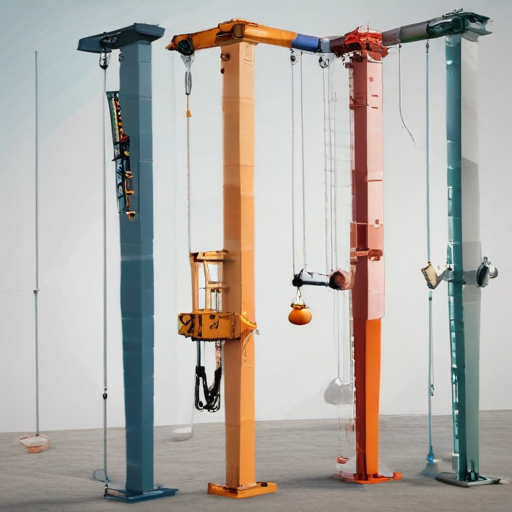
List Application of “column mounted jib crane”
A column-mounted jib crane is a versatile lifting device used in various industries to handle materials efficiently and safely. Here are some common applications:
1. Manufacturing Plants: Used for lifting, moving, and positioning heavy equipment and materials, enhancing productivity and safety in assembly lines and workstations.
2. Warehouses and Distribution Centers: Facilitates the loading and unloading of goods, organizing inventory, and transferring items between different areas, making operations more efficient.
3. Automotive Industry: Assists in handling heavy vehicle parts, such as engines and transmissions, improving the efficiency of assembly lines and maintenance tasks.
4. Metal Fabrication Shops: Essential for moving metal sheets, beams, and components, enabling precise positioning for cutting, welding, and assembly processes.
5. Construction Sites: Aids in lifting construction materials, such as beams, panels, and other heavy items, ensuring safe and efficient handling.
6. Docks and Shipyards: Facilitates the loading and unloading of cargo from ships, handling heavy machinery and materials used in shipbuilding and repair operations.
7. Mining and Quarrying: Used to lift and transport heavy mining equipment and materials, contributing to the efficiency and safety of extraction and processing operations.
8. Chemical and Pharmaceutical Plants: Helps in handling heavy containers and equipment, ensuring safe and efficient processes in sensitive environments.
9. Food and Beverage Industry: Used for lifting and moving heavy bags of ingredients, equipment, and packaged goods, improving operational efficiency and safety standards.
10. Railway and Transport Sector: Assists in lifting and maintenance of heavy train components, such as wheels and engines, enhancing operational efficiency and safety in transportation hubs.
In summary, column-mounted jib cranes are indispensable in various sectors, ensuring efficient material handling, boosting productivity, and enhancing safety across multiple industrial applications.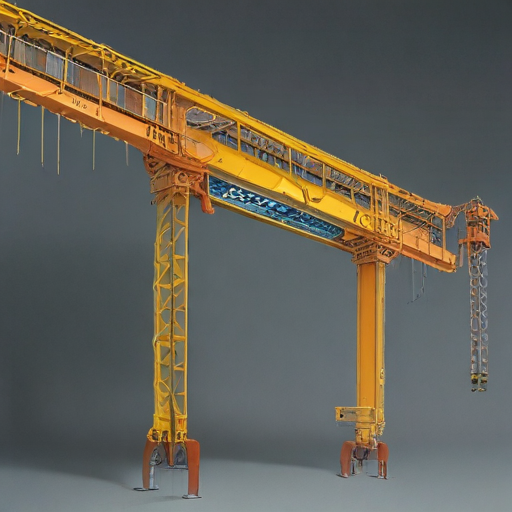
List Buyer Types of “column mounted jib crane”
A “column mounted jib crane” is a versatile lifting solution used in various industrial settings due to its efficiency and capability to handle a range of tasks. Here’s a list of potential buyer types for this equipment:
1. Manufacturing Plants: These facilities require robust and reliable lifting solutions to handle heavy components, materials, and finished products within the production line.
2. Warehouses and Distribution Centers: For efficient material handling, loading, and unloading, column-mounted jib cranes help streamline operations.
3. Automotive Industry: Used in assembly lines and for the handling of car parts, engines, and other heavy components.
4. Aerospace Industry: Essential for the precise handling and assembly of aircraft components and materials.
5. Metalworking and Fabrication Shops: For handling raw materials and finished parts, these cranes enhance productivity and safety.
6. Construction Sites: Useful for lifting materials and tools, particularly in confined or indoor areas.
7. Maritime and Shipping Facilities: For the loading and unloading of cargo and materials from dock areas.
8. Maintenance and Repair Workshops: Essential for lifting heavy machinery or components for inspection and repair.
9. Chemical and Pharmaceutical Plants: Used for handling large containers and equipment safely, following stringent regulations.
10. Mining Operations: Facilitate the movement of heavy rocks, minerals, and machinery within the mining site.
11. Food and Beverage Industry: For handling bulk materials and heavy machinery in compliance with hygiene standards.
12. Power Plants: Used for maintenance and installation of heavy components like turbines and generators.
13. Research Laboratories: Especially in facilities dealing with heavy experimental setups and equipment.
These diverse buyer types illustrate the wide range of applications and industries that benefit from the functionality and adaptability of column-mounted jib cranes, making them a valuable asset in improving efficiency and safety in various operational contexts.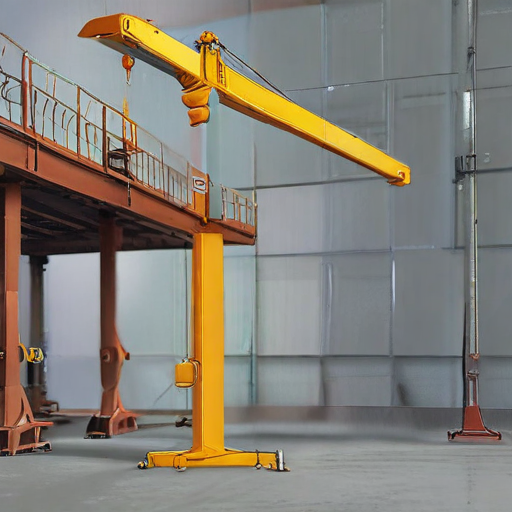
List “column mounted jib crane” Project Types for Different Industries
Column-mounted jib cranes are versatile lifting devices used across various industries to improve material handling efficiency and safety. Here are some common project types where these cranes prove invaluable:
1. Manufacturing:
– Assembly Lines: Ideal for transporting parts along the production line, increasing efficiency and reducing manual labor.
– Machinery Maintenance: Used to lift heavy machine parts for maintenance or repairs.
– Materials Movement: Facilitates the movement of raw materials and finished products within the plant.
2. Warehousing and Logistics:
– Loading and Unloading: Essential for quickly loading and unloading goods from trucks or pallets.
– Inventory Management: Assists in organizing and transporting inventory, improving warehouse workflow.
3. Automotive Industry:
– Workshop Applications: Used for lifting engines and other heavy components in repair and assembly workshops.
– Production Lines: Enhances efficiency in assembling various auto parts.
4. Construction:
– Site Materials Handling: Assists in lifting and moving construction materials around the site.
– Tool Transportation: Helps in transporting heavy tools and equipment to different work areas.
5. Aerospace:
– Component Assembly: Utilized for the precise placement and assembly of large aircraft components.
– Maintenance, Repair, and Overhaul (MRO): Simplifies the handling of heavy aircraft parts during maintenance and repair operations.
6. Marine:
– Dockside Operations: Used for loading and unloading cargo from ships.
– Shipbuilding: Assists in assembling and moving large ship components.
7. Agriculture:
– Farm Equipment Maintenance: Useful in lifting heavy machinery parts for maintenance.
– Material Handling: Aids in transporting heavy supplies like feed and fertilizers within farm facilities.
8. Energy and Utilities:
– Power Plants: Used in handling heavy equipment during maintenance or installations.
– Water Treatment Facilities: Assists in the movement of large pumps and other equipment.
These applications illustrate the adaptability and critical role of column-mounted jib cranes in enhancing operational efficiency and safety across various sectors.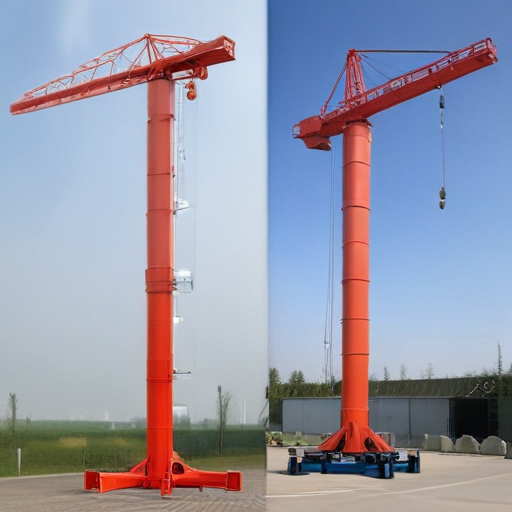
column mounted jib crane Accessories Upgrades and Custom Manufacturing Options
Column-mounted jib cranes are essential for material handling in various industrial settings. To enhance functionality and tailor them to specific needs, several accessories, upgrades, and custom manufacturing options are available.
Accessories:
1. Electric Hoists: For improved lifting efficiency and ease of use.
2. Manual Chain Hoists: Cost-effective for lighter loads and lower usage frequencies.
3. Trolleys: Motorized or manual, allowing for horizontal movement along the jib arm.
4. Remote Controls: For safer and more convenient operations.
5. Boom Locks: For securing the jib in place when not in use, enhancing safety.
6. Festoon Systems: For organizing and supporting cables and hoses.
7. Rotation Stops: Limiting the rotation for enhanced safety in confined spaces.
8. Maintenance Platforms: For easier servicing of the crane system.
Upgrades:
1. Increased Load Capacity: Customizing the crane to handle heavier loads.
2. Extended Boom Length: For greater reach, accommodating larger workspaces.
3. 360-Degree Rotation: Allowing unrestricted movement around the column.
4. Weatherproofing: For outdoor or harsh environment operations.
5. Anti-collision Devices: Enhancing safety by preventing crashes with other equipment or structures.
6. Variable Speed Controls: Offering smoother and safer operation.
7. Load Indicators: Displaying real-time weight of the load being lifted.
Custom Manufacturing Options:
1. Material Customization: Use of stainless steel or other specialized materials for corrosive environments.
2. Custom Paint and Finishes: To meet organizational branding or specific environmental requirements.
3. Height Adjustments: Custom column heights to match overhead clearance restrictions or specific operational needs.
4. Special Mounting Requirements: Custom base plates or mounting systems for unique installation environments.
5. Integrated Workstations: Design modifications to include workbenches or tool racks.
Choosing the right combination of these accessories, upgrades, and custom manufacturing options ensures that a column-mounted jib crane is perfectly suited to your specific operational requirements, maximizing productivity and safety.
List Quality Control and The Manufacturing Process of “column mounted jib crane”
Quality Control and Manufacturing Process of Column-Mounted Jib Crane
*Manufacturing Process:*
1. Design and Engineering:
– Initial designs are created using CAD software.
– Load calculations, structural analysis, and safety factors are assessed.
– Detailed drawings are prepared for manufacturing.
2. Material Selection:
– High-quality steel is selected for columns, booms, and supports.
– Specifications for bolts, bearings, and other components are determined.
3. Cutting and Shaping:
– Steel plates and sections are cut using CNC machines and laser cutters for high precision.
– Components are shaped through processes such as bending, machining, and forging.
4. Welding and Assembly:
– Welders assemble the crane’s components, ensuring structural integrity.
– Nondestructive testing (NDT) methods like X-ray, ultrasonic, or magnetic particle inspection check weld quality.
5. Surface Treatment:
– Components undergo sandblasting to remove impurities.
– Anti-corrosion treatments, such as galvanizing or painting, are applied.
6. Machining:
– Precision machining ensures components meet specified tolerances.
– Bores, keyways, and other critical features are machined.
7. Assembly and Testing:
– Boom, column, bearing, and other parts are assembled.
– Mechanical and electrical systems (if motorized) are integrated.
– Load testing is conducted to ensure operational safety and performance.
*Quality Control:*
1. Incoming Material Inspection:
– Raw materials are inspected for compliance with specifications (e.g., chemical composition, dimensions).
2. In-Process Inspections:
– Regular checks during manufacturing (e.g., weld integrity, dimensional accuracy).
– Use of calibrated instruments for high precision.
3. Final Inspection and Testing:
– Load tests to verify crane capacity.
– Safety inspections to ensure all components function correctly.
– Certification by qualified inspectors.
4. Documentation and Traceability:
– Maintaining records of materials, tests, and inspections.
– Ensuring full traceability of every component.
5. Continuous Improvement:
– Feedback loops from performance data and customer input.
– Regular reviews and updates to processes and standards.
This structured approach ensures that column-mounted jib cranes are manufactured to the highest quality and safety standards.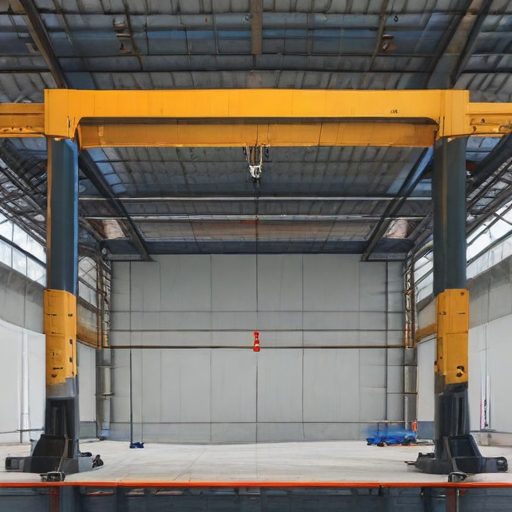
How to use “column mounted jib crane”
Using a column-mounted jib crane involves several steps to ensure safety and efficiency. Below is a concise guide.
1. Inspection:
– Pre-use Inspection: Examine the crane for any visible damage or wear. Check cables, hoist, and column for integrity. Ensure that the area around the base is clear of obstructions.
– Operational Check: Test the controls, brakes, and emergency stop before lifting any loads.
2. Setup:
– Positioning: Ensure the crane’s swing is unobstructed for the full radius of its range. Confirm that the load path is clear.
– Load Attachment: Securely attach the load using appropriate slings, hooks, or other lifting devices. Ensure the load is balanced and stable.
3. Operation:
– Lifting: Gradually take up the slack in the hoist cable until the load is lifted off the ground. Keep the load as close to the floor as possible.
– Swinging: Rotate the boom arm slowly to prevent sudden movements. Use smooth, controlled motions to position the load.
– Lowering: Carefully lower the load to its designated spot. Ensure the area below is clear of personnel before lowering.
4. Safety Precautions:
– Training: Only trained personnel should operate the jib crane.
– Load Limits: Never exceed the crane’s rated capacity. Check the load chart and adhere to it strictly.
– Communication: Maintain communication with co-workers during operation, especially in noisy environments.
– Emergency Protocols: Be familiar with emergency procedures and know how to use the emergency stop.
5. Post-Use:
– Shut Down: Turn off the crane’s power and secure the load hook in a safe, elevated position.
– Inspection: Perform a post-use inspection for any signs of wear or damage. Report any issues immediately.
Summary:
Inspection, careful setup, controlled operation, strict adherence to safety protocols, and regular inspections are key to effectively using a column-mounted jib crane. These steps help in ensuring both operator safety and operational efficiency.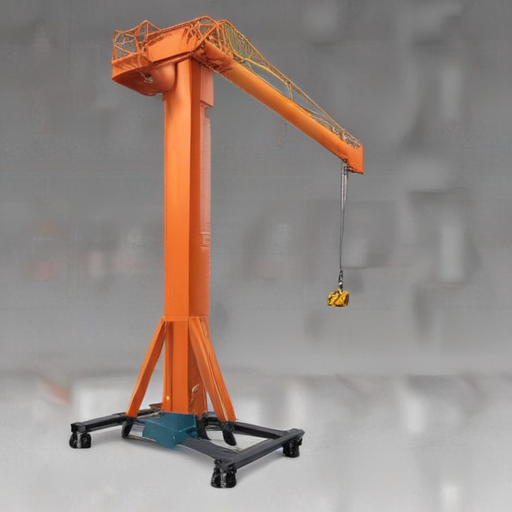
“column mounted jib crane” Comparative Analysis
A column-mounted jib crane is a versatile lifting device primarily used in industrial settings for material handling within a confined or specific area. Here’s a comparative analysis of this crane type based on key factors:
Design and Structure:
– Column-Mounted Jib Cranes: Securely mounted on a vertical column, typically bolted to the floor with concrete anchors. The crane arm (jib) can rotate around the column, allowing for a full 360-degree or limited rotation, depending on the model.
– Wall-Mounted Jib Cranes: Unlike column-mounted versions, these cranes are attached to existing walls or vertical structures, which can save floor space but provide limited rotation (usually up to 200 degrees).
Load Capacity and Range:
– Column-Mounted Jib Cranes: Generally offer higher load capacities, handling weights ranging from a few hundred kilograms to several tons. The height and arm length can be customized to accommodate the specific needs of a facility.
– Comparative Cranes: Portable gantry cranes might offer similar capacities but lack the fixed stability and can only operate within limited areas.
Installation and Space Utilization:
– Column-Mounted Jib Cranes: Require professional installation involving concrete work for stability. They occupy floor space but offer extensive range and coverage.
– Overhead Bridge Cranes: While overhead cranes maximize floor space usage, their installation is significantly more complex and costly. Their operational scope often covers entire rooms or warehouses.
Flexibility and Operation:
– Column-Mounted Jib Cranes: These cranes offer a balance between fixed stability and operational flexibility. The jib’s rotation allows for efficient loading, unloading, and positioning within their operational radius.
– Mobile Cranes: More flexible in terms of relocation but less stable and generally unable to handle the same high loads or provide continuous operation in a fixed area.
Cost:
– Column-Mounted Jib Cranes: Typically less expensive than complex overhead crane systems both in terms of initial investment and maintenance. However, they are more costly than simple hoists or portable gantry models.
Conclusion:
Column-mounted jib cranes provide an optimal balance of flexibility, load capacity, and simplicity in installation for predefined areas. They are especially advantageous in small to mid-sized operations requiring regular material movement within a confined space.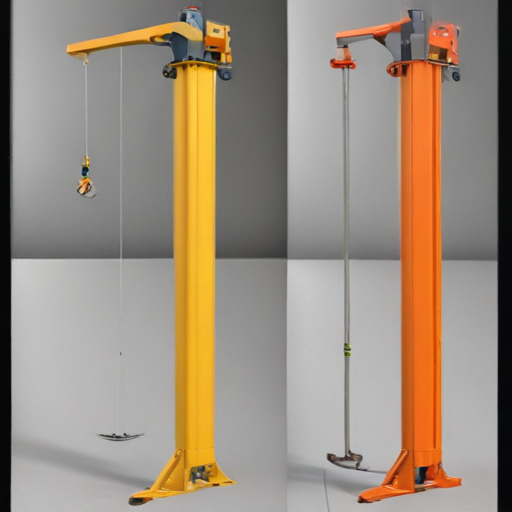
“column mounted jib crane” Warranty and Support
Warranty and Support for Column Mounted Jib Crane
Warranty:
Our column mounted jib cranes come with a comprehensive warranty to ensure your investment remains protected. We offer a standard one-year warranty covering all manufacturing defects, material faults, and workmanship issues. This ensures that any malfunction or breakdown attributable to these factors will be promptly addressed at no additional cost.
To extend the lifespan and reliability of your crane, we also offer extended warranty packages up to three years. These extended plans provide added peace of mind by covering the crane against most operational wear and tear. Routine inspections, maintenance services, and any required replacement parts are encompassed within these extended warranties.
Support:
Our commitment to your satisfaction doesn’t end with the sale of our jib cranes; we provide robust customer support to ensure smooth, continuous operation. Our customer service team is available 24/7 to address any issues or queries you might have.
Technical Assistance:
Our expert technicians are always on standby to provide both remote and on-site technical assistance. Whether it’s a minor question or a significant technical issue, our team is equipped to handle it efficiently. We also provide detailed user manuals, maintenance checklists, and troubleshooting guides to assist your in-house technicians.
Training Programs:
We offer training programs for your operators and maintenance staff to ensure they are well-versed in the safe and efficient use of our jib cranes. These training sessions can be conducted on-site or virtually, based on your preference.
Preventive Maintenance:
To reduce downtime and extend the life of your crane, we offer preventive maintenance contracts. Our team will schedule regular check-ups and maintenance work to identify and resolve potential issues before they become major problems.
With our comprehensive warranty and dedicated support services, you can trust that your column mounted jib crane will perform reliably for many years to come.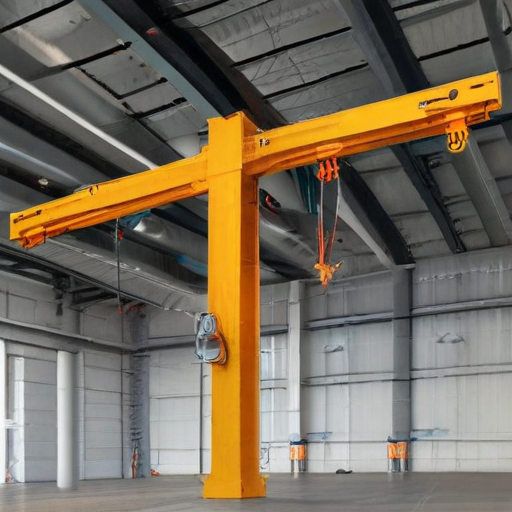
List “column mounted jib crane” FAQ
Sure, here is a concise list of FAQs for a column-mounted jib crane:
1. What is a Column Mounted Jib Crane?
A column-mounted jib crane is a type of crane that has a horizontal jib or boom attached to a vertical column, used for lifting and moving materials within a fixed radius.
2. What are its primary uses?
It is typically used in industrial environments for tasks such as loading/unloading materials, assembly line movements, and positioning of workpieces.
3. What are the weight capacities?
Capacities can range from 100 kg to several tonnes, depending on the specific design and model.
4. What is the typical boom length?
Boom lengths vary but can extend from a few meters to over 5 meters based on the application needs.
5. How is it powered?
Column-mounted jib cranes can be manually operated or powered by electrical systems.
6. What are the rotation capabilities?
Many models offer 180° to 360° rotation. The choice depends on your operational requirements.
7. What are the installation requirements?
A solid foundation is crucial. The column must be securely anchored to handle the operational loads without tipping.
8. Do I need any special maintenance?
Regular inspection and lubrication of moving parts, checking for wear and tear, and ensuring electrical systems (if applicable) are in good condition are essential.
9. What safety features are included?
Safety features may include overload protection, emergency stop buttons, and safety latches.
10. What standards and certifications should I look for?
Ensure compliance with relevant local and international safety standards, such as ANSI, OSHA, and CE certifications.
11. Are there customization options?
Yes, many manufacturers provide custom designs to meet specific needs, including customized heights, boom lengths, and control systems.
12. How can I ensure optimal performance?
Regular training for operators and adhering to the manufacturer’s guidelines for maintenance and operation are key to ensuring longevity and efficiency.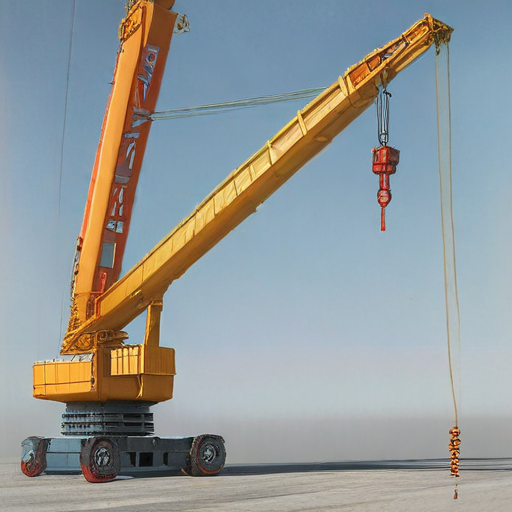
Top 10 FAQ with answer about column mounted jib crane for Buyer Sourcing from China
Certainly! Here are the top 10 frequently asked questions (FAQ) about sourcing column mounted jib cranes from China, with succinct answers:
1. What is a column mounted jib crane?
A column mounted jib crane is a lifting device with a horizontal jib or boom attached to a vertical column. It provides localized lifting and material handling within a limited area.
2. What are the typical lifting capacities available?
Common lifting capacities range from 250 kg to 10,000 kg. Custom capacities can be designed based on specific requirements.
3. What materials are used in manufacturing these cranes?
High-strength steel is typically used for the column and jib, with components like motors and controls commonly sourced from reliable suppliers to ensure durability.
4. What are the advantages of sourcing from China?
Competitive pricing, advanced manufacturing capabilities, and a robust supply chain make China an attractive source for jib cranes. Many Chinese manufacturers meet international quality standards, such as ISO and CE certifications.
5. How can I ensure the quality of the cranes?
Look for manufacturers with certifications such as ISO 9001, CE, and compliance with applicable safety standards. Request third-party inspection reports and conduct on-site factory visits if feasible.
6. What is the typical lead time for manufacturing and delivery?
Lead times can range from 4 to 12 weeks, depending on the complexity of the crane and volume of the order. Shipping can take an additional 2-6 weeks.
7. What are the shipping options?
Most suppliers offer options including FOB (Free On Board), CIF (Cost, Insurance, and Freight), and DDP (Delivered Duty Paid). Freight can be shipped by sea or air, depending on urgency and budget.
8. Is customization available?
Yes, most manufacturers offer customization options, including specific jib lengths, heights, and load capacities to meet unique operational needs.
9. What is the typical warranty period?
Warranties usually range from 12 to 24 months, covering manufacturing defects. It’s crucial to confirm warranty terms directly with the supplier.
10. What after-sales services are provided?
Reputable suppliers offer comprehensive after-sales support, including spare parts, technical assistance, and can sometimes provide on-site services depending on the location.
By addressing these key concerns, buyers can make more informed decisions when sourcing column mounted jib cranes from China.

